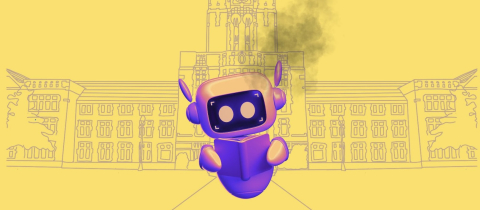Just about any subject becomes more interesting with a deeper dive. That is certainly the case for curling, a sport that is a mystery to many and unfortunately often the butt of jokes. However, it is a sport that has a rich history, one that features strategy, athleticism, good sportsmanship, and plenty of science!
The basic principle behind sweeping is deceptively simple. The heat produced by the friction generated by sweeping melts the ice and produces a thin layer of water over which the heavy granite stone slides more easily since the friction between the stone and water is less than that between the stone and ice. This means that sweeping in front of the stone prevents it from slowing down and makes it go further. But it does something else as well. Sweeping can change the path the stone takes, that is, the degree to which it “curls.”
Here the science gets complicated. Why does the stone curl at all? That is due to it being released with a slight clockwise or counterclockwise twist. This means the front of the stone is turning in one direction while the rear is turning in the opposite direction. However, the stone is tilted ever so slightly in the forward direction so that there is more melting of the ice in the front due to the downward pressure than at the rear. A clockwise-turning stone, therefore, curls to the right because it follows the path of least resistance. The more effective the sweeping, the more the overall friction between the ice and the stone is reduced and the less the stone will curl.
There’s still more. The sheet of curling ice is not smooth but “pebbled,” a result of spraying with a fine mist of water that leaves tiny bumps as it freezes. This allows the stones to slide more easily because the contact of the stone is only with the top of the bumps, reducing friction. Curlers have to gauge the pebbling of a particular sheet of ice to evaluate the effect it may have on the speed of the stone and on sweeping.
Then there is the question of the broom! And therein lies a stunning, and perhaps surprising, amount of research. The earliest descriptions of curling date back to the 16th century in Scotland, with ordinary household brooms made of corn husks being used. Today’s curling brooms are light years away from the ones you might buy at Walmart to sweep the kitchen floor. The handles can be made of carbon fibre or fibreglass, are available with different flexibilities, and can be fitted with rigid or gimbaled heads to which a brush made of diverse materials is attached.
There are horse- or hog-hair brushes, but the most popular ones are made of various blends of synthetics like nylon, polyester, or polyurethane. Competitions usually stipulate the use of standardized brushes, an outcome of “brushgate,” a controversy that erupted in 2015 when some brushes were deemed to offer a competitive advantage. Of course, the sweeping efficacy depends not only on the brush but also on the sweeper. This is where athleticism comes in. Rapid sweeping is challenging and requires the sweeper not only to be in good condition but also to be able to maneuver effectively on the ice. Shoes are important! Lots of science here too. One shoe slides, and the other grips the ice. The sliding sole can be Teflon or PVC, and the gripping sole some sort of rubber.
As far as strategy in curling goes, it is way too complicated to describe. You really have to get into watching the sport to appreciate it. But watching doesn’t give you an idea about just how difficult it is to curl. I have a tiny inkling because I was once invited to give it a try at the historic Royal Montreal Curling Club, the oldest curling club in North America, established in 1807. Believe me, it is much, much harder than it looks! Curling is a very gentlemanly, or gentlewomanly, sport. No matter who wins, once the game is over, tradition dictates that you socialize with your opponent and that even extends to the Olympics. At least it did until COVID-19 swept that tradition away.







